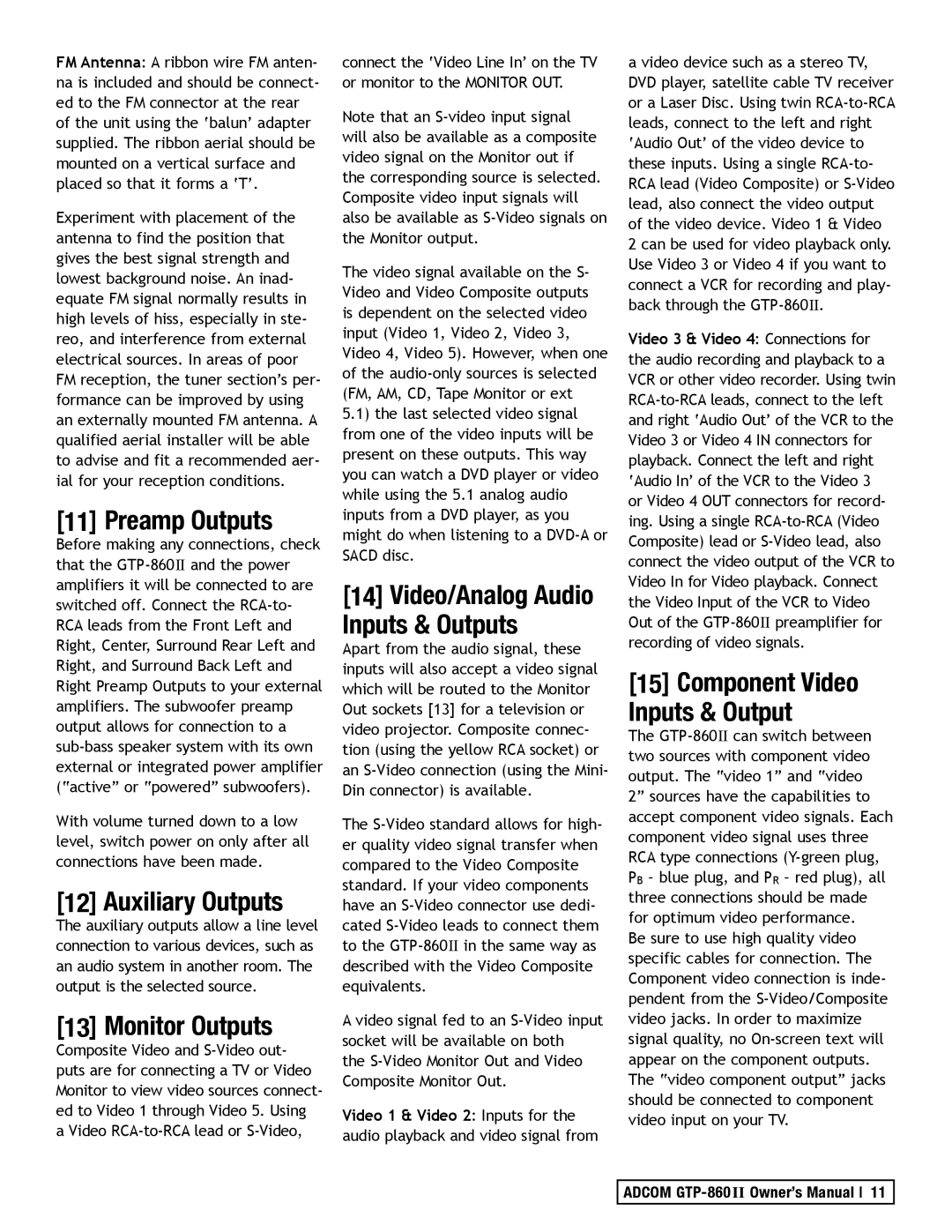FM Antenna: A ribbon wire FM anten- na is included and should be connect- ed to the FM connector at the rear of the unit using the ‘balun’ adapter supplied. The ribbon aerial should be mounted on a vertical surface and placed so that it forms a ‘T’.
Experiment with placement of the antenna to find the position that gives the best signal strength and lowest background noise. An inad- equate FM signal normally results in high levels of hiss, especially in ste- reo, and interference from external electrical sources. In areas of poor FM reception, the tuner section’s per- formance can be improved by using an externally mounted FM antenna. A qualified aerial installer will be able to advise and fit a recommended aer- ial for your reception conditions.
[11] Preamp Outputs
Before making any connections, check that the GTP-860IIand the power amplifiers it will be connected to are switched off. Connect the RCA-to- RCA leads from the Front Left and Right, Center, Surround Rear Left and Right, and Surround Back Left and Right Preamp Outputs to your external amplifiers. The subwoofer preamp output allows for connection to a sub-bass speaker system with its own external or integrated power amplifier (“active” or “powered” subwoofers).
With volume turned down to a low level, switch power on only after all connections have been made.
[12] Auxiliary Outputs
The auxiliary outputs allow a line level connection to various devices, such as an audio system in another room. The output is the selected source.
[13] Monitor Outputs
Composite Video and S-Video out- puts are for connecting a TV or Video Monitor to view video sources connect- ed to Video 1 through Video 5. Using a Video RCA-to-RCA lead or S-Video,
connect the ‘Video Line In’ on the TV or monitor to the MONITOR OUT.
Note that an S-video input signal will also be available as a composite video signal on the Monitor out if the corresponding source is selected. Composite video input signals will also be available as S-Video signals on the Monitor output.
The video signal available on the S- Video and Video Composite outputs is dependent on the selected video input (Video 1, Video 2, Video 3, Video 4, Video 5). However, when one of the audio-only sources is selected (FM, AM, CD, Tape Monitor or ext
5.1) the last selected video signal from one of the video inputs will be present on these outputs. This way you can watch a DVD player or video while using the 5.1 analog audio inputs from a DVD player, as you might do when listening to a DVD-A or SACD disc.
[14] Video/Analog Audio Inputs & Outputs
Apart from the audio signal, these inputs will also accept a video signal which will be routed to the Monitor Out sockets [13] for a television or video projector. Composite connec- tion (using the yellow RCA socket) or an S-Video connection (using the Mini- Din connector) is available.
The S-Video standard allows for high- er quality video signal transfer when compared to the Video Composite standard. If your video components have an S-Video connector use dedi- cated S-Video leads to connect them to the GTP-860IIin the same way as described with the Video Composite equivalents.
A video signal fed to an S-Video input socket will be available on both
the S-Video Monitor Out and Video Composite Monitor Out.
Video 1 & Video 2: Inputs for the audio playback and video signal from
a video device such as a stereo TV, DVD player, satellite cable TV receiver or a Laser Disc. Using twin RCA-to-RCA leads, connect to the left and right ‘Audio Out’ of the video device to these inputs. Using a single RCA-to- RCA lead (Video Composite) or S-Video lead, also connect the video output of the video device. Video 1 & Video
2 can be used for video playback only. Use Video 3 or Video 4 if you want to connect a VCR for recording and play- back through the GTP-860II.
Video 3 & Video 4: Connections for the audio recording and playback to a VCR or other video recorder. Using twin RCA-to-RCA leads, connect to the left and right ‘Audio Out’ of the VCR to the Video 3 or Video 4 IN connectors for playback. Connect the left and right ‘Audio In’ of the VCR to the Video 3 or Video 4 OUT connectors for record- ing. Using a single RCA-to-RCA (Video Composite) lead or S-Video lead, also connect the video output of the VCR to Video In for Video playback. Connect the Video Input of the VCR to Video Out of the GTP-860IIpreamplifier for recording of video signals.
[15] Component Video Inputs & Output
The GTP-860IIcan switch between two sources with component video output. The “video 1” and “video 2” sources have the capabilities to accept component video signals. Each component video signal uses three RCA type connections (Y-green plug, PB – blue plug, and PR – red plug), all three connections should be made for optimum video performance.
Be sure to use high quality video specific cables for connection. The Component video connection is inde- pendent from the S-Video/Composite video jacks. In order to maximize signal quality, no On-screen text will appear on the component outputs. The “video component output” jacks should be connected to component video input on your TV.
